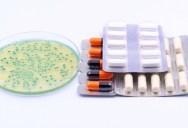Scientists Say This New Antibiotic Will Put “Resistant” Bugs In Their Place

The discovery of antibiotics is one of the medical advances that allowed our population to explode.
It’s also the thing that allows human beings to not have to fear dying from every single little bug that comes our way.
Recently there has been fear again, due to certain bugs that have been shown to be resistant to the most readily-available and most-effective antibiotics available.
Now, researchers say that worry could soon be a thing of the past.
They say it kills bacteria with a dual-pronged approach called macrolones; the drugs target to bacterial processes at the same time.
The scientists behind this new study say it will make evolving resistance 100 million times more difficult for those tricky bacterium out there.

This is important, as the World Health Organization estimates that in 2019, 1.27 million global deaths resulted from antibiotic resistance.
Those “superbugs” threaten to return us to the days of fearing even the most minor infection, but scientists are determined not to let that happen.
The best way to do that would be a drug like this one, that will last a very long time without worries about resistance.
Senior author Alexander Mankin gave a statement on their findings.
“The beauty of this antibiotic is that it kills through two different targets in bacteria. If the antibiotic hits both targets at the same concentration, then the bacteria lose their ability to become resistant via acquisition of random mutations in any of the two targets.”
Macrolones bring together two widely-used antibiotics that target cells from opposite angles.
The first are macrolides like erythromycin, which are commonly used to treat upper respiratory infections and STIs. They work by preventing bacteria from manufacturing the proteins they need to function by blocking the ribosome.
The second are fluoroquinolones like ciprofloxacin, which is more broad-spectrum and works by targeting a bacterial enzyme called DNA gyrase. This stops the DNA from creating the correct structure.
This new class of antibiotic targets both cellular processes equally.
“By basically hitting two targets at the same concentration, the advantage is that you make it almost impossible for the bacteria to easily come up with a simple genetic defense.”

Further development and testing will be necessary, but the early results are very promising.
“The main outcome from all of this work is the understanding of how we need to go forward. And the understanding that we’re giving to chemists is that you need to optimize these macrolones to hit both targets.”
It’s good news for human beings all over the world.
But not for the crafty bacteria. Oh, well.
Thought that was fascinating? Here’s another story you might like: Why You’ll Never See A Great White Shark In An Aquarium

Sign up to get our BEST stories of the week straight to your inbox.




